Digital Poster
X-Nuclei MR
ISMRM & ISMRT Annual Meeting & Exhibition • 03-08 June 2023 • Toronto, ON, Canada

| Computer # | |||
|---|---|---|---|
4714.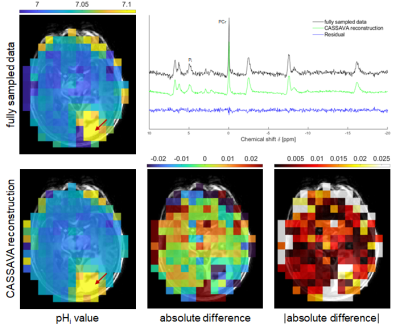 |
121 |
CASSAVA: a Compressed Adaptive SenSing Algorithm with Variable
k‑space Averaging for high‑resolution volumetric 31P MRSI at 7T
Gino G. Rincon1,2,
Philip S. Boyd1,
Vanessa L. Franke1,2,
Cornelius J. Bauer1,2,
Mark E. Ladd1,2,3,
Peter Bachert1,2,
and Andreas Korzowski1
1Division of Medical Physics in Radiology, German Cancer Research Center (DKFZ), Heidelberg, Germany, 2Faculty of Physics and Astronomy, University of Heidelberg, Heidelberg, Germany, 3Faculty of Medicine, University of Heidelberg, Heidelberg, Germany Keywords: Non-Proton, Spectroscopy, Phosphorous MRSI Compressed sensing (CS) techniques suggest the feasibility of reducing the measurement duration of high‑resolution 31P‑MRSI at 7T to a clinically reasonable time (20 minutes) while preserving data quality. The proposed Compressed Adaptive SenSing Algorithm with Variable k‑space Averaging (CASSAVA) reconstructs 31P‑MRSI data with an undersampling factor of $$$R=3.8$$$ while simultaneously maintaining spectral peak accuracy and a high spatial resolution. This was demonstrated in the conducted simulation, retrospective, and prospective studies by evaluating the reconstructed spectra and intracellular pH maps of healthy and tumor tissues as a benchmark test. As a result, clinical research on larger patient cohorts becomes feasible. |
|
4715.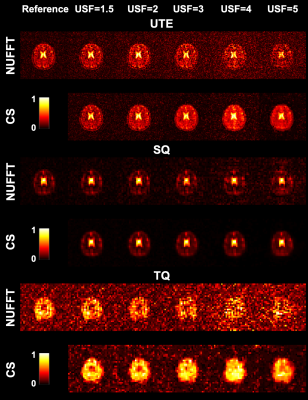 |
122 |
Accelerated Enhanced Simultaneous Single-Quantum and
Triple-Quantum-Filtered Sodium MRI Using Compressed Sensing at
7T
Qingping Chen1,2,
Wieland A. Worthoff1,
and N. Jon Shah1,3,4,5
1Institute of Neuroscience and Medicine 4, Forschungszentrum Jülich GmbH, Jülich, Germany, 2Faculty of Medicine, RWTH Aachen University, Aachen, Germany, 3Institute of Neuroscience and Medicine 11, Forschungszentrum Jülich GmbH, Jülich, Germany, 4JARA–BRAIN–Translational Medicine, Aachen, Germany, 5Department of Neurology, RWTH Aachen University, Aachen, Germany Keywords: Non-Proton, Pulse Sequence Design, Multiple-quantum filtering; Sodium MRI Enhanced simultaneous single-quantum and triple-quantum-filtered imaging of 23Na (SISTINA) enables images to be weighted towards restricted sodium, a promising biomarker for clinical practice, but suffers from long acquisition times and low image quality. However, this can be alleviated by applying compressed sensing (CS). This work establishes a novel enhanced SISTINA sequence using FLORET sampling at 7T and demonstrates that CS can accelerate SISTINA acquisitions with less noise and better structure preservation than non-uniform fast Fourier transform while maintaining proper weightings towards total, non-restricted, and restricted sodium. The reduced acquisition time facilitates the clinical transition of enhanced SISTINA. |
|
4716.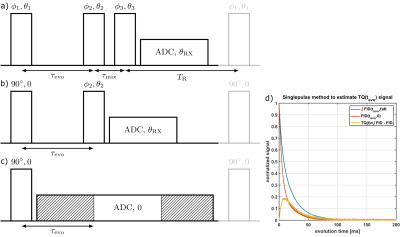 |
123 |
23Na Triple Quantum (TQ) Signal Estimation from Single-Pulse
Sequence with Single Quantum (SQ) Time Efficiency
Simon Reichert1,
Victor Schepkin2,
Dennis Kleimaier1,
and Lothar Schad1
1Medical Faculty Mannheim, Heidelberg University, Mannheim, Germany, 2National High Magnetic Field Laboratory, Tallahassee, FL, United States Keywords: Non-Proton, Non-Proton, Sodium, X-Nuclei, Triple-Quantum, TQ, new contrast mechanism This study demonstrates a method to estimate the biological relevant sodium TQ signal with a single-pulse sequence. Comparison of this method with theory and experiments using TQTPPI sequence showed a close agreement of the TQ signal. Therefore, the TQ signal can be estimated on the time scale of sodium SQ signal acquisition using the proposed sequence. |
|
4717. |
124 |
Dual responsive MR probe based on oxidation-triggered chemical
shift
Natalia Ziolkowska1,2,
Katerina Sulkova1,
Lucie Kracikova3,
Martin Vit1,
Richard Laga3,
and Daniel Jirak1
1Department of Diagnostic and Interventional Radiology, Institute for Clinical and Experimental Medicine, Prague, Czech Republic, 2First Faculty of Medicine, Institute of Biophysics and Informatics, Charles University, Prague, Czech Republic, 3Department of Polymer and Colloid Immunotherapeutics, Institute of Macromolecular Chemistry, Czech Academy of Sciences, Prague, Czech Republic Keywords: Non-Proton, Tumor Presented novel phosphorus- and fluorine-containing polymer possess high sensitivity at 31P/19F-MR and a large chemical shift from biological phosphorus signal (∆δ=60 ppm) due to phosphorothioate P=S group in its structure. The probe represents a conceptually new approach for phosphorus MR, as it undergoes oxidation-induced structural changes in the presence of ROS, represented in greater amounts in cancer tissue. The additional 19F-MR signal serve as an on-site information on the polymer distribution in the organism. |
|
4718.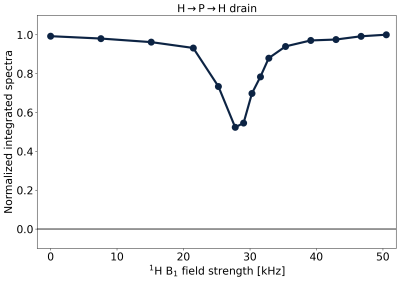 |
125 |
Solid state NMR in white matter: Unconventional 31P→1H cross
polarization interrogates the proton pool
Alex Ensworth1,2,
Cariad-Arianna Knight1,
Piotr Kozlowski1,2,3,4,
Cornelia Laule1,2,3,5,
Alex L. MacKay1,3,4,
and Carl A. Michal1
1Physics and Astronomy, University of British Columbia, Vancouver, BC, Canada, 2International Collaboration on Repair Discoveries (ICORD), University of British Columbia, Vancouver, BC, Canada, 3Radiology, University of British Columbia, Vancouver, BC, Canada, 4UBC MRI Research Centre, University of British Columbia, Vancouver, BC, Canada, 5Pathology & Laboratory Medicine, University of British Columbia, Vancouver, BC, Canada Keywords: Non-Proton, White Matter, myelin, phosphorus, hydrogen, spinal cord tissue, cross polarization, NMR, microstructure Tools to better characterize myelin health are urgently needed. We demonstrate the use of the solid-state NMR techniques cross polarization (CP) and WIdeline Separation (WISE) to directly probe the phosphorous (31P) of phospholipid myelin bilayers and characterize protons (1H) involved in CP. This work demonstrates the feasibility of unconventional CP from 31P→1H in porcine spinal cord and investigates the contributing 1H. The results of this work provide crucial insight into the characteristics exploitable by CP in myelin and reinforce the potential of a two-step transfer of semi-solid 31P signals into aqueous 1H, providing a more direct and myelin-specific MRI signal. |
|
4719.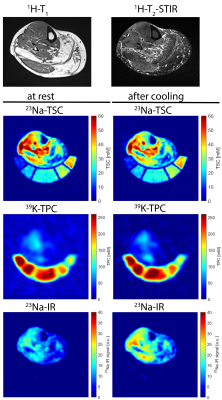 |
126 |
7-T 39K/23Na MRI for assessment of ionic balance in patients
exhibiting hypokalemic periodic paralysis
Claudius Sebastian Mathy1,2,
Armin Michael Nagel1,3,
Matthias Türk4,5,
Michael Uder1,
Rafael Heiß1,
Marc-André Weber6,
and Lena Vanessa Gast1
1Institute of Radiology, University Hospital Erlangen, Friedrich-Alexander-Universität Erlangen-Nürnberg (FAU), Erlangen, Germany, 2Department of Radiology and Biomedical Imaging, Magnetic Resonance Research Center, Yale University, New Haven, CT, United States, 3Division of Medical Physics in Radiology, German Cancer Research Center (DKFZ), Heidelberg, Germany, 4Department of Neurology, University Hospital Erlangen, Friedrich-Alexander-Universität Erlangen-Nürnberg (FAU), Erlangen, Germany, 5Centre for Rare Diseases Erlangen (ZSEER), University Hospital Erlangen, Friedrich-Alexander-Universität Erlangen-Nürnberg (FAU), Erlangen, Germany, 6Institute of Diagnostic and Interventional Radiology, Pediatric Radiology and Neuroradiology, University Medical Center Rostock, Rostock, Germany Keywords: Non-Proton, Muscle, Potassium Combined 39K/23Na MRI at 7T has become feasible recently after technical advances of 39K MRI. Here we assessed ion homeostasis alterations, especially tissue potassium and sodium concentrations (TPC/TSC) in a small pilot cohort of patients of hypokalemic periodic paralysis (HypoPP). Depending on the severity of fatty involvement of muscles, TSC was elevated in slightly to moderately involved muscles and TPC showed a tendency to decrease in an inverse correlated fashion. Almost entirely fatty infiltrated muscle showed a decrease of TSC and TPC. Therefore, combined 39K/23Na MRI could help to examine the pathophysiological processes in HypoPP and other muscular channelopathies. |
|
4720.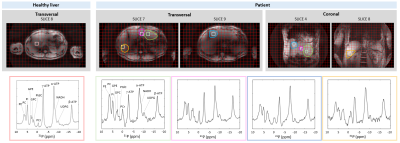 |
127 |
Spatially resolved assessment of 31P metabolite levels in liver
metastases with 31P MRSI at 7T
Lieke van den Wildenberg1,
Bobby Runderkamp2,
Leonard Seelen1,
Hanneke van Laarhoven3,4,
Mark Gosselink1,
Wybe van der Kemp1,
Nadia Haj Mohammad5,
Dennis Klomp1,
and Jeanine Prompers1
1Center for Image Sciences, University Medical Center Utrecht, Utrecht, Netherlands, 2Department of Radiology and Nuclear Medicine, Amsterdam UMC, Amsterdam, Netherlands, 3Department of Medical Oncology, Amsterdam UMC, Amsterdam, Netherlands, 4Imaging and Biomarkers, Cancer Center Amsterdam, Amsterdam, Netherlands, 5Department of Medical Oncology, Utrecht Medical Center Utrecht, Utrecht, Netherlands Keywords: Non-Proton, Cancer Methods for early treatment response evaluation to systemic therapy of liver metastases are lacking. Tumor tissue is characterized by an increased PME/PDE ratio. However, with commonly used 31P surface coils for liver 31P MRS, the liver is not fully covered. Using an integrated 31P whole-body transmit coil in combination with a 16-channel body receive array at 7T, we were able to spatially map 31P metabolite levels throughout the whole liver in a patient with liver metastases. We found highly elevated levels of both PE/ATP and PC/ATP in liver metastases in comparison with healthy liver tissue. |
|
4721.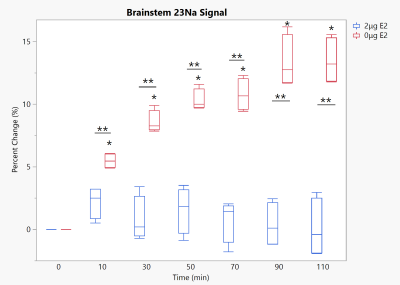 |
128 |
23Na MRI at 21.1T reveals the Impact of Estrogen Deprivation in
Preclinical Migraine
Dayna L. Richter1,2,
Samuel Holder1,2,
and Samuel Colles Grant1,2
1National High Magnetic Field Laboratory, Florida State University, Tallahassee, FL, United States, 2Chemical & Biomedical Engineering, FAMU-FSU College of Engineering, Tallahassee, FL, United States Keywords: Non-Proton, Neuro, Migraine, Extreme field Migraine disproportionately affects women in part due to menstrual migraine, linked to 17β-estradiol deprivation. This study implements 23Na MRI at 21.1 T in female Sprague-Dawley rats to evaluate the impact of estradiol deprivation on widespread sodium increases previously reported in the male model. Ovariectomy was implemented, and animals dosed with controlled estradiol to mimic the natural estrus cycle. It was found that females at physiological estradiol concentrations are resilient to sodium increases in the brainstem and CSF, while estradiol deprivation removes this resiliency. This interaction may play a role in menstrual migraine, and the clinical migraine gap between sexes. |
|
4722.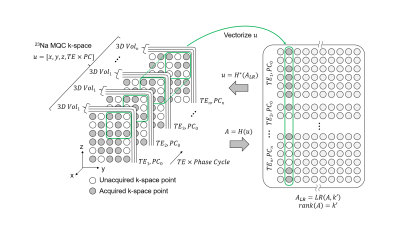 |
129 |
Accelerated in-vivo 23Na Multi-Quantum Coherences MRI by
utilizing Low-Rank Matrix Completion
Christian Licht1,
Stanislas Rapacchi2,
and Lothar R. Schad1
1Computer Assisted Clinical Medicine, Heidelberg University, Mannheim, Germany, 2CRMBM, Aix-Marseille Université, Marseille, France Keywords: Non-Proton, Multi-Contrast, Sodium Sodium (23Na) MRI has received increased attention as a potential biomarker for disease states thanks to the advent of ultra-high field MRI. One interesting asset from 23Na MRI is the distinction between single and triple quantum signal to further characterize tissues. However, 3D 23Na multi-quantum coherences (MQC) imaging requires multiple radiofrequency phase-cycling, which is inherently time-consuming and therefore difficult to include in protocols. In this work, we propose to accelerate 23Na MQC MRI by leveraging multi-dimensional under-sampling coupled with a dedicated Low-Rank matrix completion image reconstruction. |
|
4723.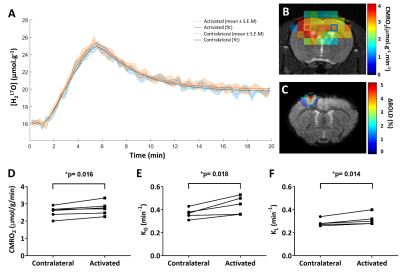 |
130 |
17O-MRI of the cerebral metabolic rate of oxygen during
electrical stimulation of the paws in the rat at 11.7 T
Amelie Tourais1,
Cameron Hery1,
Martine Guillermier1,
Julien Valette1,
and Celine Baligand1
1Université Paris-Saclay, CEA, CNRS, MIRCen, Laboratoire des Maladies Neurodégénératives, Fontenay-aux-Roses, France Keywords: Non-Proton, Metabolism CMRO2 is an important metric for the evaluation of neurovascular and neurometabolic coupling. However, the degree of coupling between brain activity and CMRO2 remains a matter of debate. In this work, we used 17O-ZTE-MRI at 11.7 T to measure CMRO2 during neuronal activation in the rat primary somatosensory cortex. To improve measurements sensitivity, we acquired data over two consecutive cycles of 17O2 inhalation-washout. We show that a significant functional increase in CMRO2 (+7±5%, p=0.016), and in the rates of metabolized water gain and loss KG (+19±11%, p=0.18) and KL (10±6%, p=0.014) can be detected with good spatial resolution after summation. |
|
4724. |
131 |
Skin Sodium Concentration Measurement Increased with
Surface-Coils, Higher Resolution Voxel Reshaping, and Lower
Flip-Angles
Jingxuan Zhu1,
Christian Beaulieu1,
Karim Damji1,
and Rob Stobbe1
1Biomedical Engineering, University of Alberta, Edmonton, AB, Canada Keywords: Non-Proton, Body Non-proton (23Na) MRI studies have measured greater body tissue (skin) sodium concentration in disorders such as hypertension, diabetes, and chronic kidney disease, but literature values of ~15 mM are well below the 77 mM from atomic absorption spectroscopy. Previous studies have used gradient-echo imaging with long TE=2 ms, knee volume-coils, and large 3×3×30=270 mm3 voxels. Here, short TE=0.1 ms twisted projection imaging is used, and signal loss is progressively lowered with surface coil imaging, reshaped 0.4x4x4 = 6.4 mm3 voxels, and lower 60o flip-angle excitation, ultimately yielding 42 mM calf skin measurement in 10 young adults. |
|
4725.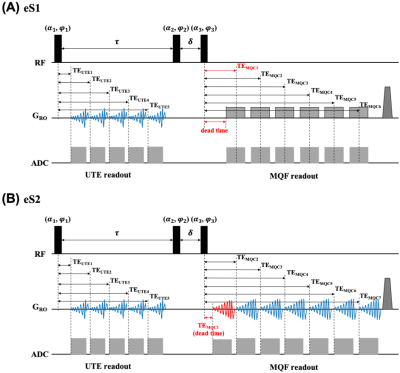 |
132 |
Optimisation of Simultaneously Acquired Single and Triple
Quantum Filtered Sodium MRI for Relaxometry at 7T
Wieland A. Worthoff1,
Qingping Chen1,2,
and N. Jon Shah1,3,4,5
1Institute of Neuroscience and Medicine - 4, Forschungszentrum Jülich GmbH, Jülich, Germany, 2Faculty of Medicine, RWTH Aachen University, Jülich, Germany, 3Institute of Neuroscience and Medicine - 11, Forschungszentrum Jülich GmbH, Jülich, Germany, 4Faculty of Medicine, RWTH Aachen University, Aachen, Germany, 5JARA-BRAIN - Translational Medicine, Jülich-Aachen Research Alliance, Aachen, Germany Keywords: Non-Proton, Relaxometry, Sodium, Multiple Qunatum Filtering Sodium relaxometry has great potential value for research and clinical practice. Enhanced Simultaneously Acquired Single and Triple Quantum Filtered Imaging of Sodium (eSISTINA) can yield information on both fast and slow transversal relaxation times. The eSISTINA sequence is optimised by adding an early echo in the multiple-quantum-filtered readout train using FLORET k-space trajectories. The optimised sequence is compared and verified against a conventional, Cartesian multi-echo gradient echo based enhanced eSISTINA sequence on a group of four healthy volunteers. The experimental results show that the optimised sequence has better in vivo relaxometry performance than the conventional sequence. |
|
4726.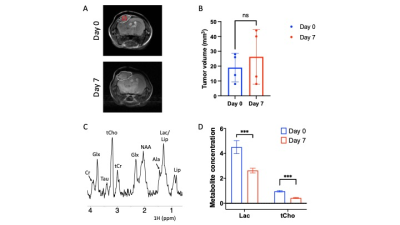 |
133 |
Metabolic imaging of response to therapy in pediatric diffuse
midline gliomas
Georgios Batsios1,
Celine Taglang1,
Meryssa Tran1,
Anne Marie Gillespie1,
and Pavithra Viswanath1
1University of California, San Francisco, San Francisco, CA, United States Keywords: Non-Proton, Metabolism, preclinical, animals, brain, spectroscopy, deuterium Diffuse midline gliomas (DMGs) are lethal pediatric brain tumors. DMG patients are typically treated with radiation in combination with an experimental agent in clinical trials. ONC206 is a novel drug with promising efficacy in preclinical models. Successful clinical translation and deployment of ONC206 requires the identification of companion biomarkers of treatment response. Therefore, the goal of this study was to identify magnetic resonance spectroscopy (MRS)-detectable biomarkers of response to ONC206 in preclinical DMG models. Our studies identify a combination of 1H- and 2H-MRS-detectable biomarkers that serve as imaging biomarkers of early response to ONC206 in mice bearing intracranial DMG xenografts. |
|
4727.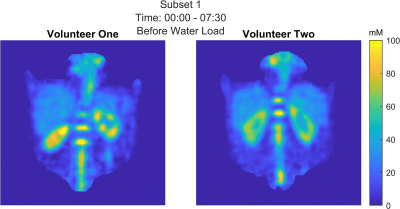 |
134 |
Quantitative sodium MRI of the human kidneys at 7T – Before,
during and after water load via sliding window evaluation
Anna K. Scheipers1,2,
Armin M. Nagel1,3,
Laurent Ruck3,
Lena V. Gast3,
Mark E. Ladd1,2,4,
and Tanja Platt1
1Medical Physics in Radiology, German Cancer Research Center (DKFZ), Heidelberg, Germany, 2Faculty of Physics and Astronomy, Heidelberg University, Heidelberg, Germany, 3University Hospital Erlangen, Institute of Radiology, Friedrich‐Alexander‐Universität Erlangen‐Nürnberg (FAU), Erlangen, Germany, 4Faculty of Medicine, Heidelberg University, Heidelberg, Germany Keywords: Non-Proton, High-Field MRI, Kidney, Quantitative Imaging 23Na-MRI is a non-invasive tool for the in-vivo quantification of the tissue sodium concentration (TSC); however, it suffers from low in-vivo signals and short relaxation times. High magnetic field strengths, dedicated hardware and pulse sequences as well as various correction methods contribute to obtaining reliable TSCs. In the presented work we employ a custom-built coil and reference vial setup and perform T1, B1+ and B1- corrections that were validated in phantom measurements. We use a sliding window reconstruction for the quantitative 23Na-images to investigate the changes in the TSC before, during and after a water load in two healthy volunteers. |
|
4728.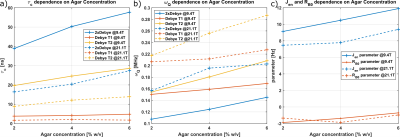 |
135 |
Combining Extreme Narrowing and Slow Motion Regime in a Simple
Motional Model for Sodium NMR Environment.
Simon Reichert1,
Victor Schepkin2,
Dennis Kleimaier1,
and Lothar Schad1
1Medical Faculty Mannheim, Heidelberg University, Mannheim, Germany, 2National High Magnetic Field Laboratory, Tallahassee, FL, United States Keywords: Non-Proton, Non-Proton, Sodium, X-Nuclei, Very-High B-Field This study investigates a model of ion motion that is compatible with 23Na T1 and T2 mechanism of relaxation and even works with quasi mono-exponential T1. We compare this model with the commonly used Debye model using agar as a tissue model system at 9.4T and 21.1T. |
|
4729.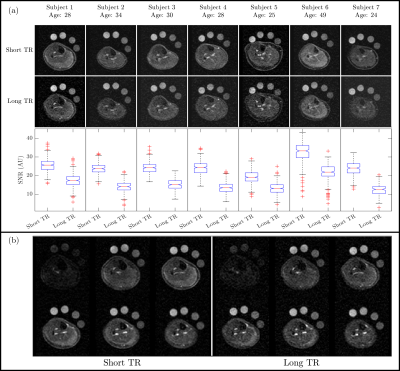 |
136 |
Comparison of short and long TR Gradient Recalled Echo (GRE)
measures for total sodium concentration mapping in the calf
Ben Prestwich1 and
Susan Francis1
1Sir Peter Mansfield Imaging Centre, University of Nottingham, Nottingham, United Kingdom Keywords: Non-Proton, Non-Proton, sodium MRI, T1 mapping, muscle, tissue sodium concentration Sodium (23Na) MRI measures of tissue are SNR limited. Here, we compare a 3D gradient recalled echo (GRE) 23Na scans with a short TR and fully recovered TR for estimation of tissue sodium concentration (TSC) in the calf. We validate measures by collecting 23Na T1 measures of the calf and reference bottles. A short TR scan is shown to provide increased image SNR, resulting in higher measures of TSC, along with improved depiction of the skin. Using the short TR GRE scan, older subjects and haemodialysis patients are shown to have higher calf TSC than younger subjects. |
|
4730.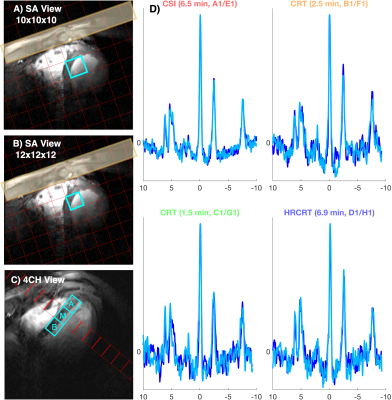 |
137 |
Reproducibility of 7T human cardiac 3D 31P-MRSI using concentric
ring k-space trajectories (CRT).
Ferenc E Mózes1,
William T Clarke2,
and Ladislav Valkovič1,3
1Oxford Centre for Clinical MR Research (OCMR), RDM Cardiovascular Medicine, University of Oxford, Oxford, United Kingdom, 2Wellcome Centre for Integrative Neuroimaging, FMRIB, Nuffield Department of Clinical Neurosciences, University of Oxford, Oxford, United Kingdom, 3Department of Imaging Methods, Institute of Measurement Science, Slovak Academy of Sciences, Bratislava, Slovakia Keywords: Non-Proton, Heart, phosphorus Cardiac 31P-MRS provides insight into metabolism of the failing heart. The commonly employed 3D-MRSI acquisitions are rather slow, even at 7T. Fast readout trajectories, such as concentric ring (CRT) have been recently suggested to substitute the slow Cartesian sampling (CSI), however their repeatability is yet unknown. Our preliminary data suggest comparable intra-session repeatability, but somewhat lower inter-session repeatability for mid septal voxels using 2.5 min CRT in comparison to 6.5 min CSI. Similar trends were observed for higher resolution CRT. |
|
4731.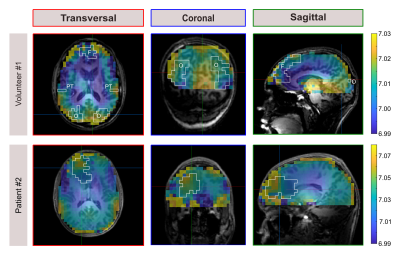 |
138 |
Analysis of regional differences in pH values obtained via 31P
MRSI at 7T
Justyna Platek1,2,
Florian Kroh1,2,
Vanessa L. Franke1,2,
Philip S. Boyd1,
Nina Weckesser3,
Heinz-Peter Schlemmer3,4,
Daniel Paech3,5,
Mark E. Ladd1,2,4,
Peter Bachert1,2,
and Andreas Korzowski1
1Division of Medical Physics in Radiology, German Cancer Research Center (DKFZ), Heidleberg, Germany, 2Faculty of Physics and Astronomy, University of Heidelberg, Heidelberg, Germany, 3Division of Radiology, German Cancer Research Center (DKFZ), Heidleberg, Germany, 4Faculty of Medicine, University of Heidelberg, Heidelberg, Germany, 5Division of Neuroradiology, University Hospital Bonn, Bonn, Germany Keywords: Non-Proton, Spectroscopy, Phosphorus, pH, cancer In this study, we analyzed pH values obtained via high-resolution 31P MRSI at 7T in different subjects and different regions of the human brain, and identified a trend towards lower pH values in the frontal region compared to other brain regions. The potential regional variation should be taken into account in cases, where only small pH changes between different tissues are expected and partial volume effects might dominate. |
|
The International Society for Magnetic Resonance in Medicine is accredited by the Accreditation Council for Continuing Medical Education to provide continuing medical education for physicians.